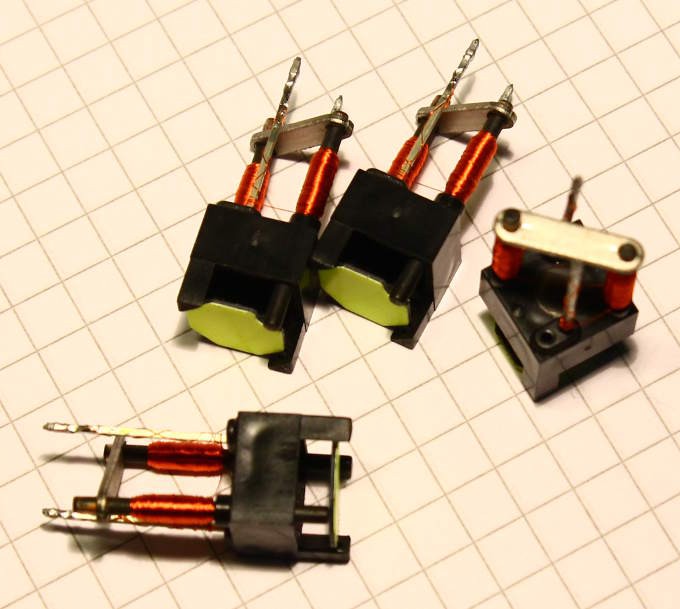While rumaging through my stash, looking for electromagnets, guess what I found ?
Yes, memories from Active Surplus, a now closed Toronto surplus store. Damn, I miss you guys...
4 individual flip dots, 10×10mm, that flip at about 1.5V and 70mA (they are measured at 19.2 ohms).
I might use them for showing status (like Z and C flags) and they are easily interfaced in a CCPBRL way : one leg to 0V, the other leg tied to a capacitor (it worked with 100µF under 3V but 470µ is better) that swings from 0 to 3V... or something like that. Hysteresis is built into the system (through ferrite that stores the magnetic flux) so there is no need to maintain a bias current.
Which makes me think...
 Yann Guidon / YGDES
Yann Guidon / YGDES
Discussions
Become a Hackaday.io Member
Create an account to leave a comment. Already have an account? Log In.
I like the idea of using the flip dots as indicators. They are such cool displays ;)
Are you sure? yes | no
Yes, indeed !
I have only 4 so I must choose wisely.
OTOH I have some hundreds of "Glühbirnchen" (tiny incandescent lamps) which would be awesome, if only they didn't draw 50mA@3V. Displaying the whole register set's values in binary would consume 12A/ or about 40W...
Now that I think of it, maybe I have to use one flip dot array to display the register set, but I have only 2 arrays that I dedicated to the memory, and the dimensions are not suitable (16×28, I need 18×16).
I also consider the Lixie approach or something similar...
Are you sure? yes | no
Oh yes, the Lixie is very cool. And very affordable. It has a modern look though (at least to me). If you want that, cool, but I know some people want a retro/nixie look. It's all the experience of inventing and learning though, isn't it?
Are you sure? yes | no
Nixies would be interesting though I have doubts about practicality... And I have not seen hexadecimal Nixies yet (and I don't want to do octal :-D)
The look is only one part though. I try to design a sort of playground that is pretty safe, so no high voltages or temperatures.
For now I ponder about the practicality of doing a quadruple Hex=>7 segments decoder to display the Imm16 field :-D
Are you sure? yes | no
>And I have not seen hexadecimal Nixies yet (and I don't want to do octal :-D)
I have a twenty 14 segments +comma/dot display. It was from an old pinball machine.
Are you sure? yes | no
@K.C. Lee I maybe have used the wrong word then, I was thinking about stacked digits
https://en.wikipedia.org/wiki/Nixie_tube
Or something like this
or
https://www.tindie.com/products/connornishijima/lixie-an-led-alternative-to-the-nixie-tube/
I was not thinking about VFD :-)
Are you sure? yes | no
It is the technology not the form.
Are you sure? yes | no
For the form and technology, I will let common sense (parts count and power consumption) decide.
I'm not sure of the right trade-off :
* 7-segments light several segments at the same time but require less segments.
* unary require 2× more display points but only one at a time
I can deal with diode matrices, though I'll need to wire 4 of them :-D
Are you sure? yes | no
Make a backlit wheel of digits out of a PCB driven by modified relay with ratchet. It would fit in better with the electro-mechanical theme.
Are you sure? yes | no
Hahahaha :-)
I had considered making a crude 4-bits DAC and labeling a needle ammeter, or something like that...
Are you sure? yes | no
Wonder if these could be made DIY at home, perhaps larger.
Are you sure? yes | no
more or less, the principle is pretty simple :-)
* find a permanent magnetic material, make a very thin and lightweight "dot"
* find hysteretic material, some ceramic/iron/ferrite/whatever and make a U
* wind a magnetic coil around the U so you can control the magnetic field in the ferrite
* pass some current in the coil to reverse the stored magnetic field => the magnet will align and flip !
Are you sure? yes | no
Yeah, thinking along those lines, more worried about building something like that with my fat fingers :-) might have a go with it at that :-)
Are you sure? yes | no